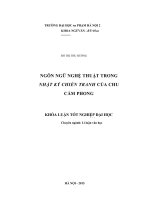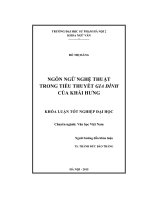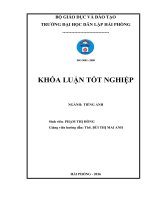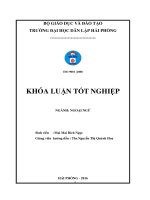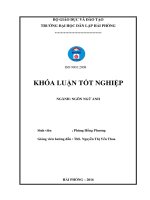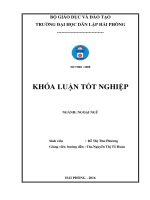Khóa luận tốt nghiệp ngoại ngữ vietnamese translation of idioms in love story by erich segal
Bạn đang xem bản rút gọn của tài liệu. Xem và tải ngay bản đầy đủ của tài liệu tại đây (701.96 KB, 54 trang )
BỘ GIÁO DỤC VÀ ĐÀO TẠO
TRƯỜNG ĐẠI HỌC DÂN LẬP HẢI PHÒNG
-------------------------------
ISO 9001 :2008
KHÓA LUẬN TỐT NGHIỆP
NGÀNH: TIẾNG ANH
Sinh viên: PHẠM THỊ HỒNG
Giảng viên hướng dẫn: ThS. BÙI THỊ MAI ANH
HẢI PHÒNG - 2016
BỘ GIÁO DỤC VÀ ĐÀO TẠO
TRƯỜNG ĐẠI HỌC DÂN LẬP HẢI PHÒNG
-----------------------------------
VIETNAMESE TRANSLATION OF IDIOMS IN
LOVE STORY BY ERICH SEGAL
KHÓA LUẬN TỐT NGHIỆP ĐẠI HỌC HỆ CHÍNH QUY
NGÀNH: TIẾNG ANH
Sinh viên
: PHẠM THỊ HỒNG
Lớp
: NA1601
Giảng viên hướng dẫn: ThS. BÙI THỊ MAI ANH
HẢI PHÒNG - 2016
BỘ GIÁO DỤC VÀ ĐÀO TẠO
TRƯỜNG ĐẠI HỌC DÂN LẬP HẢI PHÒNG
--------------------------------------
NHIỆM VỤ ĐỀ TÀI TỐT NGHIỆP
Sinh viên: PHẠM THỊ HỒNG
Mã SV:1212751009
Lớp: NA1601
Ngành: TIẾNG ANH
Tên đề tài: VIETNAMESE TRANSLATION OF IDIOMS IN LOVE
STORY BY ERICH SEGAL
NHIỆM VỤ ĐỀ TÀI
1. Nội dung và các yêu cầu cần giải quyết trong nhiệm vụ đề tài tốt
nghiệp
(về lý luận, thực tiễn, các số liệu cần tính toán và các bản vẽ).
………………………………………………………………………
………………………………………………………………………
………………………………………………………………………
………………………………………………………………………
………………………………………………………………………
………………………………………………………………………
………………………………………………………………………
………………………………………………………………………
2. Các số liệu cần thiết để thiết kế, tính toán.
………………………………………………………………………
………………………………………………………………………
………………………………………………………………………
………………………………………………………………………
………………………………………………………………………
………………………………………………………………………
………………………………………………………………………
………………………………………………………………………
………………………………………………………………………
3. Địa điểm thực tập tốt nghiệp.
………………………………………………………………………
………………………………………………………………………
………………………………………………………………………
CÁN BỘ HƯỚNG DẪN ĐỀ TÀI TỐT NGHIỆP
Người hướng dẫn thứ nhất:
Họ và tên: Bùi Thị Mai Anh
Học hàm, học vị: Thạc sỹ
Cơ quan công tác: Khoa Ngoại ngữ, Đại học Dân lập Hải Phòng
Nội dung hướng dẫn:…................................................................
Người hướng dẫn thứ hai:
Họ và tên:.........................................................................
Học hàm, học vị:...............................................................
Cơ quan công tác:..............................................................
Nội dung hướng dẫn:............................................................
Đề tài tốt nghiệp được giao ngày
tháng
Yêu cầu phải hoàn thành xong trước ngày
Đã nhận nhiệm vụ ĐTTN
năm
tháng
năm
Đã giao nhiệm vụ ĐTTN
Người hướng dẫn
Sinh viên
Hải Phòng, ngày ...... tháng........năm 2016
Hiệu trưởng
GS.TS.NGƯT Trần Hữu Nghị
PHẦN NHẬN XÉT CỦA CÁN BỘ HƯỚNG DẪN
1. Tinh thần thái độ của sinh viên trong quá trình làm đề tài tốt
nghiệp:
………………………………………………………………………
………………………………………………………………………
………………………………………………………………………
………………………………………………………………………
………………………………………………………………………
2. Đánh giá chất lượng của khóa luận (so với nội dung yêu cầu đã đề ra
trong nhiệm vụ Đ.T. T.N trên các mặt lý luận, thực tiễn, tính toán số
liệu…):
………………………………………………………………………
………………………………………………………………………
………………………………………………………………………
………………………………………………………………………
………………………………………………………………………
………………………………………………………………………
………………………………………………………………………
3. Cho điểm của cán bộ hướng dẫn (ghi bằng cả số và chữ):
……………………………………………………………………
……………………………………………………………………
……………………………………………………………………
Hải Phòng, ngày … tháng … năm 2016
Cán bộ hướng dẫn
(Ký và ghi rõ họ tên)
NHẬN XÉT ĐÁNH GIÁ
CỦA NGƯỜI CHẤM PHẢN BIỆN ĐỀ TÀI TỐT NGHIỆP
1. Đánh giá chất lượng đề tài tốt nghiệp về các mặt thu thập và phân
tích tài liệu, số liệu ban đầu, giá trị lí luận và thực tiễn của đề tài.
............................................................................................................................
............................................................................................................................
............................................................................................................................
............................................................................................................................
............................................................................................................................
............................................................................................................................
............................................................................................................................
............................................................................................................................
2. Cho điểm của người chấm phản biện : ………………………..
(Điểm ghi bằng số và chữ)
Ngày.......... tháng........năm 2016
Người chấm phản biện
TABLE OF CONTENT
ACKNOWLEDGEMENTS .............................................................................
ABSTRACT ......................................................................................................
LIST OF ABBREVIATION…………………………………………………..
LIST OF TABLES ............................................................................................
LIST OF FIGURES ..........................................................................................
TABLE OF CONTENTS .................................................................................
PART I: INTRODUCTION
1. Rationale ...................................................................................................... 1
2. Objectives of the study ................................................................................ 2
3. Scope of the study ........................................................................................ 2
4. Significances of the study............................................................................ 3
5. Thesis organization ..................................................................................... 3
PART II: DEVELOPMENT
CHAPTER 1: THEORETICAL BACKGROUND .................................. 5
1. The relationship between idiomatic translation, language and culture .......... 5
2. Translation ................................................................................................. 8
Definition of translation ......................................................................... 8
Translation process ................................................................................ 8
Form and meaning in translation ........................................................... 9
Equivalence in translation ...................................................................... 11
Translation strategies ............................................................................. 13
Using translation strategy of similar meaning and form ........................ 14
Using translation strategy of similar meaning but form ........................ 14
Using translation by paraphrase ............................................................. 14
Using translation by omission ................................................................ 15
3. Idioms ........................................................................................................... 16
Definition of idioms ................................................................................. 16
Types of idioms ........................................................................................ 16
Sources of idioms ..................................................................................... 18
Specific characteristics of idiomatic meanings ........................................ 19
The difficulties in the translation of Idioms............................................. 19
4. Summary of the Love Story novel ............................................................. 20
CHAPTER 2: RESEARCH METHOD .................................................... 21
1. Research Approach ..................................................................................... 21
2. Data type ...................................................................................................... 21
3. Source of Data ............................................................................................. 21
4. Data collection ............................................................................................. 22
5. Data analysis ................................................................................................ 22
CHAPTER 3: FINDINGS AND DISCUSSION
1. Findings ........................................................................................................ 23
Description of the translation strategies of the Idiomatic expression
in the English – Vietnamese texts ............................................................... 23
Description of the meaning equivalence degree of the Idiomatic
expression in the English – Vietnamese texts ............................................. 24
2. Discussion ................................................................................................... 26
Translation strategies used by the translator in translating the
Idiomatic Expressions in the English- Vietnamese texts ............................ 26
Translation using an idiom of similar meaning and form................. 26
Translation using an idiom of similar meaning but dissimilar
form .................................................................................................. 27
Translation by paraphrase ................................................................. 29
The degree of Meaning Equivalence of the translation of Idiomatic
Expression in the English-Vietnamese texts ............................................... 30
Equivalence meaning ..................................................................... 30
a) Complete meaning .................................................................... 30
b) Partly equivalent ....................................................................... 31
Non-Equivalent meaning .................................................................................... 32
a) Different meaning ..................................................................... 32
b) No meaning ............................................................................... 33
3. Summary .................................................................................................... 34
PART III: CONCLUSION AND SUGGESTIONS
1. Conclusion................................................................................................ 36
2. Suggestions ............................................................................................... 36
REFERENCES .......................................................................................... 38
ACKNOWLEDGEMENT
First and foremost, I would like to express my sincere thanks to my
supervisor, Ms. Bùi Thị Mai Anh, M.A., lecturer of the Foreign Language
Department, Hai Phong Private University. This thesis could have probably
not completed without her patient, enthusiastic and instructive supervision
and encouragement.
I also would like to show my profound gratitude to all of the lecturers in
the Foreign Language Department of Haiphong Private University for
tirelessly devoting time and efforts to enrich, broaden and deepen my
knowledge over the past four years. My special thanks go as well to the
Foreign Language Department of Haiphong Private University for giving me
the opportunity and permission to implement this thesis.
Besides, I am deeply indebted to my beloved family for their
wholehearted support and encouragement. I also would like to dedicate my
special thanks to my classmates in NA1601, who have supported, cooperated
and provided me with valuable suggestions.
Finally, I cannot fully express my gratitude to all the people whose direct
and indirect support assisted me to accomplish my thesis in time.
ABSTRACT
This thesis examines the Vietnamese translation of Idioms in “Love
Story” novel by Erich Segal. The researcher uses descriptive analysis to
analyze the translation of the Idiomatic expression found in the novel. The
current project is going to concentrate mainly on translating idiomatic.
These strategies are suggested by Baker (1992). The data of this study
of are collected by taking a close look into the novel. From the analysis that
has been done, there are 14 idiomatic expressions.
The researcher concludes that there are strategies used in translating the
idioms in the novel. The first one is strategies of similar meaning and
dissimilar form with (42.86%) findings which automatically dominates in the
novel, the second one is the strategies of similar meaning and form with result
(42.86%), and the last strategy by omission (14.28%). Meanwhile, there is no
translation strategy of paraphrase.
In terms of meaning equivalence, the translation of idiomatic
expressions has higher percentages of equivalence degree indicated by
frequency of equivalent meaning (78.57%) compared to non- equivalent one
(21.43%). In short, the translator has successfully transferred the meanings of
the source text as equivalent as possible and the translation can meet the
readers‟ need for equivalent translation.
LIST OF ABBREVIATION:
SL: source language
TL: target language
P: Page
L: Line
ISMF: Idioms of Similar meaning and form
ISDF: Idioms of Similar meaning but dissimilar form
TP: Translation by paraphrase
TO: Translation by omission
LIST OF TABLES
Table 1: Frequency of Strategy Usage ............................................................ 24
Table 2: The frequency and the percentage of the Meaning Equivalence
Degree ............................................................................................................. 24
Table 3: The Frequency and the Percentage of the types of Meaning
Equivalence ..................................................................................................... 25
Table 4: The Frequency and the Percentage of the Non-Equivalent meaning
degree .............................................................................................................. 25
LIST OF FIGURES
Figure 1: Translation process by Larson (1984: 4) .......................................... 9
PART I: INTRODUCTION
1.
Rationale for the study
Language is an essential part of human‟s life. It is used to organize the
exchange of information in social situation. The existing of different
languages in the world can be an obstacle for people to communicate.
Translation has a function to abridge two or more different languages so that
people can communicate each other. Translation also can be a tool to access
and exchange information and knowledge in different languages. Without it,
people will be left behind in accessing information. Therefore, the translation
activity is important for the advancement of a nation to improve their science
and knowledge.
Idiomatic expressions are a natural part of language use. Idioms always
cause a lot of problems to learners of a foreign language. Students usually
find difficulties in recognizing an expression as idiomatic or not, and then
understanding its exact meaning. This is mainly due to the fact that an
idiomatic expression is a colloquial metaphor that requires fundamental
knowledge and experience in both the target and source languages, and the
translator must have cultural background of both the source and target texts.
According to Langlotz (2006, p. 2) “idioms have been described as
conventional multi-word units that are semantically opaque and structurally
fixed”.
While idioms are a very important part of any language, and idiom
translation plays an important role in translation. However, translation of
idiomatic expressions is often problematic for translators. Because an idiom
cannot be understood simply from the meaning of its individual words. In
other words, the actual meaning of an idiom is not the total of the meaning of
its individual parts. Thus, idiomatic expressions cannot be literally translated
into another language. An idiom or fixed expression is hardly ever matched
1
between the SL and the TL.
Based the explanation above, it is interested to analyze the translation
of idiomatic expressions in novel because idioms appear frequently in it. The
Love Story novel is taken as the object of this research because this one
contains a great deal of idiomatic expressions. It is interesting to study how
the translator employs translation strategies about the idiomatic translation in
both novels and how translator used degree of meaning equivalence. Second,
the story of the novel is interesting. The novel had been filmed in the same
title.
For this reason, the minor thesis would like to focus on translating
idiomatic expressions in “Love Story” by Erich Segal from English to
Vietnamese.
2. Objectives of the Study
The study covers the following aims:
To identify the strategies used in translating idiomatic expression found
in Bilingual Novel entitled “Love Story” by Erich Segal” into “Câu
chuyện tình yêu” by Trần Anh Kim
To describe the degree of meaning equivalence in the translation of the
idiomatic expressions
To successfully achieve the above aims, the thesis seeks to answer the
two research questions:
What strategies are used in translating the idiomatic expression in
“Love Story” by Erich Segal into “Câu chuyện tình yêu” by Trần Anh
Kim?
What degree is meaning equivalence represented in the translation of
the idiomatic expressions?
3. The Scope of the Study
2
Translation is the most important thing in transferring the source
language to the target language. One of the problematic factors involved in
translation is idiomatic; it needs special knowledge to understand the
meaning. This thesis study focuses on translating idiomatic expressions which
are found in the Novel entitled “Love Story” into “Câu chuyện tình yêu” by
Trần Anh Kim.
4. Significances of the Study
The researcher wants to give some benefits from this research, not only
for the researcher herself, but also for the some related parties. The benefits
are:
1. Researchers
To know about the strategies translating idiomatic expression and get new
experience in researching idiomatic expressions
2. Readers:
To know the differences of translation used in source language into target
language.
3. Haiphong Private University
Be an additional reference for translation of idiomatic expressions for
Foreign Language Department students.
The benefits are to develop the learners understanding especially the
idiom.
4. Translators
The researcher hopes that the translator can get an additional reference if
he or she conducts his or her process of translation.
5. Thesis Organization
Thesis organization is a summary of each chapter. It is to create a systematic
writing and to make it easy to the readers in understanding the content. This
3
thesis is organized as follows:
Part I is Introduction. It consists of Background of the Study, Objective
of the study, Scope of the Study, Significance of the Study, and Thesis
Organization.
Part II is Development. This part consists of three small parts:
- Chapter I is Review of Related Literature. It summarizes the most
outstanding concepts of translation, idioms and the strategies used for
the translating idiomatic expressions as well as the degree of meaning
equivalence of the translation of idiomatic expressions.
- Chapter II is Research Method. It conveys of Approach, Data type,
Source of Data, Data Collection, and Data Analysis.
- Chapter III is Findings and Discussions of the Data collected.
Part III is Conclusion and Suggestions.
4
PART II: DEVELOPMENT
CHAPTER 1: LITERATURE REVIEW
To make a good analysis, this thesis should be supported by several
related theories. The theories applied in this thesis are Translation, Idioms
,Strategies for translating idioms and the degree of Meaning Equivalence.
Below are the descriptions of the theories that are related to the problem
discussed in this study.
1. Relationship between Idiomatic translation, language and culture:
The term culture refers to a set of beliefs that control a particular
country or group behaviors. It is defined by Taylor (cited in Hymes, 1964:
455) as a complex whole which includes knowledge, beliefs, customs and any
capacities and habits acquired by man as a member of a society‟. Among
these beliefs, language is considered as an essential part that constitutes one‟s
culture. It is as the Longman dictionary describes it „the heart within the body
of culture‟ (cited in Bassnett, 1980:22). This is involved in the process of
translation through the influence of the source and target cultures. Culture has
a great impact on the process of translation in the sense that the degree of
integration of the source text (ST) in the target culture (TC) may vary, and
may cause serious problems for the translator. In this respect, culture may
lead to different types of translation. Generally, translation is the process of
transferring message and meaning from the source language (SL) into the
target language (TL). The differences in language system and structure in
both languages require a translator to understand either in the SL or in the TL.
The translator should pay attention and understand both cultural matters to
avoid misunderstanding.
Ivir (1987) stated that “language is a part of culture and, therefore,
translation from one language to another cannot be done adequately without
knowledge of the two cultures as well as the two languages structures”
5
(p.208). In this regard, Newmark (1988) believed that the untranslatability of
a certain text is more likely to exist when the level of cultural overlap between
the source language (SL) and the target language (TL) is high, which means
that it is more likely that the translator will be unable to bridge the gap
between both languages.
Dweik (2000) asserted that differences between two cultures certainly
cause difficulties not only in translation but also in learning foreign
languages. He elaborated on the causes of interference problems that result
from either lack of knowledge in language two or from language one. He also
discussed the role of non-linguistic factors that either impede or enhance
bilingualism.
Baker (1992) mentioned that “the source language word may express a
concept which is totally unknown in the target culture. The concept in
question may be abstract or concrete; it may relate to a religious belief, a
social custom or even a type of food”. She discussed the most common nonequivalents which a translator can come across in the process of translation.
Cultural differences can cause some serious difficulties for translators that are
not familiar with them. Translating idiomatic expressions can cause serious
challenges to the non-expert translator.
Idiomatic translation is not only a language conversion, but also the
transplantation of culture. Due to the historical and cultural background,
traditional customs and thinking methods that are significantly different from
one country to another, the image, meaning and usage of idioms are also quite
different. Therefore, idiom translation is one of the most difficult tasks in
intercultural communication and language learning.
According to Langlotz (2006, p. 2) "idiomatic constructions can be
described as complex symbols with specific formal, semantic, pragmatic
and sociolinguistic characteristics.” This means that an idiom is a very
complicated notion of language, which overlaps mostly with
culture.
Language is closely related to culture, and it can be regarded as a part of
6
culture. Language and culture shape and interact with each other. Idiom is a
very important form of language, which exists in both language and culture.
It carries a huge amount of information such as nationality, customs,
traditions, ceremonies, religion, geography etc. Much knowledge about
culture can be exposed through the study of idiomatic expressions and in
turn better understand of idiomatic expressions by learning their cultural
background and cultural patterns. Since each language has its own way and
devices of expressing certain ideas and issues in exposing culture, idiomatic
expressions are considered language and culture specific.
In short, language, culture and idiomatic translation always exist
together and reinforce together. The relationship between them is so close that
we could not understand or appreciate the one without the knowledge of the
other.
7
2. Translation
Definition of Translation
There are many different definitions of translation. The first is the
definition made by Newmark, a well-known researcher who has made a great
deal of important contributions to the development of translation. According
to him, “Translation is a craft consisting in the attempt to replace a written
message and statement in one language by the same message and/or
statement in another language” (Newmark, 1988a:7).
Translation is the expression in another language (target language) of
what has been expressed in one language (source language), preserving
semantic and stylistic equivalencies. (By Roger T. Bell)
Translation is the replacement of a representation of a text in one
language by a representation of an equivalent text in a second language. (By
Roger T. Bell).
Translation is rendering a written text into another language in a way
that the author intended the text. (By Bui Tien Bao – Hanoi National
University)
Translation are concerned with written texts. They render written texts
from one language into another language. Translators are required to translate
texts which arrange from simple items including birth certificates or driving
licences to more complex written materials such as articles in journals of
various kinds, business contracts and legal documents.‟‟ (Bui Tien Bao –
Hanoi National University).
Translation Process
Larson (1984: 4) states that translation can be seen as a process. The
source language consists of cultural context and situational context. They can
be divided into expressed text, lexicon, and grammar structure. These
elements consist of meaning. In translation process, meaning is analyzed and
discovered. After being discovered, the meaning is transferred into another
8
language or the receptor language. Then, the meaning is re-expressed by the
translator based on the receptor language. The source language is expressed in
re-expressed text, lexicon, and grammar structure according to the receptor
language. The process of translation can be illustrated in the following figure.
Source language
Target language
Cultural context
Cultural context
Situational context
Situational context
Expressed text Lexicon Grammar
Expressed Lexicon Grammar
text
Analysis of meaning
Re-expression of meaning
Discovery of meaning
Transfer of meaning
Meaning
Figure 1: Translation Process by Larson (1984: 4)
Form and Meaning in Translation
Larson (1984: 3) says that translation is basically a change of form. The
form refers to actual words, phrases, clauses, sentences, paragraphs, etc. The
forms are referred to the surfaces structure of language. It is the structural part
of language which is actually seen in print or heard in speech. In translation,
the form of the source language is replaced by the equivalent lexical items
(form) of the receptor of language. Nonetheless, there is often no equivalent
in the target language for a particular form in the source text (Baker,1992:24).
9
According to Larson (1984: 3), translation is done by going from the
form of the first of language to the form of a second language by semantic
structure.
When a translator makes a translation it means that he or she transfers
meaning of source text. What is necessary to consider is that the meaning
must be maintained constantly or, in other words, when the change of the
form occurs, the meaning must be maintained, it is characteristic of languages
that the same meaning component will occur in several surface structure of
lexical items (forms).
In the translation process, the first thing to do is understand the total
meaning of the source text. There are three types of meaning that can be
determined in the analysis of meaning of the source text (Nida and Taber,
1982:34), namely: grammatical meaning, referential meaning,
and
connotative meaning. Generally grammar is taken for granted since it seems
to be merely a set of arbitrary rules about arrangements, rules that must be
followed if one wants to understand, but not rules themselves that seem to
have meaning. Referential meaning refers to words as symbols which refer to
objects, event, abstract, and relations. Connotative meaning refers to how the
users of the language react, whether positively or negatively, to the words and
their combination.
Halliday (1989: xiii) says that fundamental components of meaning in
language are functional components. They are ideational, interpersonal, and
textual meanings. Further, these functions are called metafunctions and they
are present in every use of language in every social context.
The ideational metafunction is concerned with ideation or content or
one‟s experience of the world around and inside people. One of its major
grammatical systems is transitivity, the resource for construing the experience
and the flux of events. Each consists of a process, participants, and
circumstances.
The interpersonal component is concerned with the interaction between
10
the speaker and addressee. The grammatical resources are used for enacting
social roles in general and speech roles in particular in dialogic interaction.
The textual component is concerned with the creation of text with the
presentation of ideational and interpersonal meaning as information that can
be shared by the speaker and the listener in a text unfolding in context. One of
its major textual systems is theme, which is an element which serves as the
point of departure of the message.
Meaning according to Catford (1965:73) is a property of language.
Catford classifies meaning into two types; they are lexical meaning and
contextual meaning.
a. Lexical meaning is the meaning that belongs to the word individually and
specifically and that its meaning makes it different from other words. There
are four types of lexical meaning, i.e. propositioned meaning, expressive
meaning, presupposed meaning, and evoked meaning.
1) Propositioned meaning is the meaning of a word that refers to describes
things in a real or imaginary world as achieved by the speaker of
particular language where the word belongs.
2) Expressive meaning is the meaning arises from feelings or attitude of the
speaker.
3) Presupposed meaning is the meaning that is derived from the restriction
on what other words should accompany a particular lexical unit before or
after it.
4) Evoked meaning is the meaning occurred in relation to the dialect and
register variation.
In translation, the translator should know the types of meaning above.
By knowing what meaning they should produce the message of the source
text can be transferred well.
Equivalence in Translation
Equivalence becomes problematic in translation. Machali (1998:3)
states that target language equivalents have to be sought not simply in
11
terms
of the “sameness of meaning”, but in terms of the greatest possible overlap of
situational range. Thus, equivalence in translation should not be approached
for sameness, since sameness of meaning cannot easily exist between the
source language and the target language.
Meanwhile, Bell (1991: 6) states a problem of equivalence that texts in
different languages can be equivalent in different degrees (equivalent, i.e.
complete meaning, increased meaning, decreased meaning; and nonequivalent, i.e. completely different meaning and no meaning), in respect of
different levels of presentation (equivalent in respect of context, of semantics,
of grammar, of lexis, etc.) and at different ranks (word-for-word, phrase-forphrase, sentence-for sentence). Sometimes the sources language texts has the
same meaning in the target language text so that the meaning in the target
language can be said equivalent to the meaning in source language text when
they have function in the same communicative situation and express the same
purpose.
Catford (1978: 102) categorizes equivalence into two types, i.e. formal
correspondence, and textual equivalence. Formal correspondence is any target
language category (unit, class, element of structure, etc.) which can be said to
occupy as nearly as possible the same place in the economy of the target
language as the given source language category occupies in the source
language. For example: translating an adjective by an adjective.
Textual equivalence is any target language text or portion of text which is
observed on a particular occasion to be the equivalent of a given source
language text or portion of text. For example: translating adjective by an
adverbial phrase.
Baker (1992) divides equivalence into five types: (1) equivalence at
word and above word level (2) equivalence (3) textual equivalence and (4)
pragmatic equivalence. The more detailed lists of conditions upon which the
concept of equivalence can be defined are presented below.
a. Equivalence can appear at word level and above word level,
12
when

